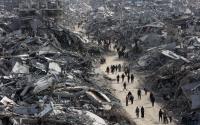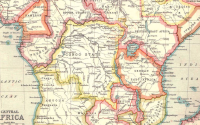December 17, 2002The Guardian
There are two planet earths. One of them is the complex, morally challenging world in which we live, threatened by ecological collapse. The other is the one we see on the wildlife programmes. We love these programmes not only because they show us how curious the products of evolution are, but also because they remove us to a parallel planet, the Garden of Eden before the sixth day of creation, when God went and messed it up by making man.
Natural history programmes lie more frequently than any other documentaries. They film animals in cages and pretend they have been filmed in the wild. They import tame predators, and release them to hunt wild prey. They cut between uneventful sequences to suggest that animals are interacting. Most of the soundtrack is added to the film in the studio: the noise of antlers clashing is likely to be the noise of technicians duelling with broomsticks.
All this technical trickery, while dishonest, is harmless enough. But there is a far more serious and dangerous lie, which informs almost every sequence the programmes show. Except for a few shots of animals doing amusing things in people's gardens, and, occasionally, an indigenous person, stripped of his T-shirt, wildlife programmes present the natural world as a pristine wilderness, unaffected by humanity.
Some of these falsehoods are brought to us by the most trusted man on television. Sir David Attenborough, is, as everyone knows, an excellent broadcaster, and he appears to be a sincere and decent man. He has never, as far as I am aware, told a lie on television. But, for much of the past 50 years, he has allowed the camera to lie on his behalf.
His programmes' invocation of a fantastic, untainted world is dangerous for two reasons. The first is that they suggest that ecosystems remain largely intact. Attenborough has made one fine series about environmental destruction. But those programmes belonged to the world we inhabit, compartmentalised and far removed from the other world he shows us. Their message has been undermined by almost every wildlife documentary he has made. Last week, for example, he explained how the harvest mouse has made its home in cornfields; but omitted the obvious development of that idea: the species has, in the past 50 years, been devastated by agricultural change.
He shows us long, loving sequences of animals whose populations are collapsing, without a word about what is happening to them. Indeed, by seeking out those places, tiny as they may be, where the habitat is intact and the population is dense, the camera deliberately creates an impression of security and abundance. Attenborough cannot tell us that this is false, for if he did so his fantasy planet would collide with the one we inhabit, and his prelapsarian spell would be broken.
More dangerously still, many of his hundreds of millions of viewers believe in the world he creates, and when they go abroad they expect to find it. There is a massive and well financed industry devoted to ensuring that they will not be disappointed.
The construction of wilderness has always been a key component of the colonial project. Almost everywhere that European settlers went, they either proclaimed the land they seized to be terra nullius or, by expelling its people, ensured that it became so. The land which many of the richest colonists sought was that which harboured great concentrations of game.
The Normans, for example, were obsessed by hunting, and many of them joined the invasion of 1066 simply to secure new reserves. Hugh le Gros Veneur ("the fat hunter"), seized vast tracts of Lancashire, which his descendants, the Grosvenors, or Dukes of Westminster, own to this day. William I established several "forests", or royal hunting estates, whose inhabitants he cleared. This is one of the reasons why both "forest" ( a word which has come to mean a place where trees grow) and the habitats of big wild animals have taken their place in our mythology of wilderness. The great "wildernesses" of Scotland were established for the same purpose and by the same means 700 years later.
But these reserves were tiny by comparison to the wildernesses the British colonists made in east Africa. At first the land they seized was set aside for hunting, but as the game ran out, they began to preserve it for the camera rather than the gun. After the second world war, Bernhard Grzimek, "the father of conservation" in east Africa, announced that he would turn the Serengeti in northern Tanzania into a vast national park. This land, which is possibly the longest-inhabited place on earth, was, he declared, a "primordial wilderness".
Though there was no evidence that local people threatened the wildlife, Grzimek decided that "no men, not even native ones, should live inside its borders". His approach was gleefully embraced by the British. Thousands of square miles of savannah in Kenya and Tanzania were annexed, and its inhabitants expelled. Only the whites could afford the entrance fees to the reserves, so only they were permitted to enter the new, primordial wilderness.
This project was, from the beginning, assisted by wildlife films. Grzimek's documentary, Serengeti Shall Not Die, generated massive enthusiasm for his ethnic cleansing programme. Joy Adamson, who was one of the most viciously racist and brutal characters ever to carve a career in Africa, used the status afforded by her books and the films they inspired to wage war on the indigenous people. She drove the eastern Samburu out of their best grazing lands to establish what she called a "conservation project" (in reality an attempt to rehabilitate her pet leopard). She described the Samburu as "squatters" and renamed the prominent features of the land she had stolen after her pets. When she was murdered in this artificial wilderness, the inquiry was delayed for months by a surfeit of suspects.
Today, conservation officials in Kenya often concede that traditional grazing could be permitted in the parks and reserves without driving out the wildlife. But the local people must continue to be excluded because the tourists "don't expect to see them there". The tourists don't expect to see them there largely because the television shows them that healthy wildlife habitats are places without people. By presenting the natural world as something apart from humanity, it creates the impression that conservation means exclusion. If those who seek to venture through the back of the television and into the world which Attenborough has made find that it is, in fact, very much like our own, with all the conflicts and difficulties which arise wherever human beings live, they will complain. So the primary task of conservationists in the former colonies is to convert the real world into the virtual one which the tourists have seen on TV.
David Attenborough has become, in two respects, godlike. He can, in the eyes of all who worship him, do no wrong. And he has created a world which did not exist before. He's a fine man, but for 50 years he has perpetuated one of humanity's most dangerous myths.






